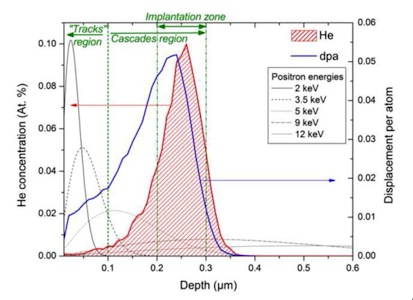Ask for a reprint
email :
* Give your email
2013
ACL
|
F.Linez, E.Gilabert, A.Debelle, P.Desgardin, M.F.Barthe, 'Helium interaction with vacancy-type defects created in silicon carbide single crystal', J. Nucl. Mater. 436 150 (2013) doi:10.1016/j.jnucmat.2013.01.288
Generation of He bubbles or cavities in silicon carbide is an important issue for the use of this material in nuclear and electronic applications. To understand the mechanisms prior to the growth of these structures, an atomic-scale study has been conducted. 6H-SiC single crystals have been implanted with 50 keV-He ions at 2×1014 and 1015 cm-2 and successively annealed at various temperatures from 150 to 1400°C. After each annealing, the defect distributions in the samples have been probed by positron annihilation spectroscopy. Four main evolution stages have been evidenced for the two investigated implantation fluences: at (1) 400°C for both fluences, (2) at 850°C for the low fluence and 950°C for the high one, (3) at 950°C for the low fluence and 1050°C for the high one and (4) at 1300°C for both fluences. The perfect correlation between the positron annihilation spectroscopy and the thermodesorption measurements has highlighted the He involvement in the first two stages corresponding respectively to its trapping by irradiation-induced divacancies and the detrapping from various vacancy-type defects generated by agglomeration processes.
|

|